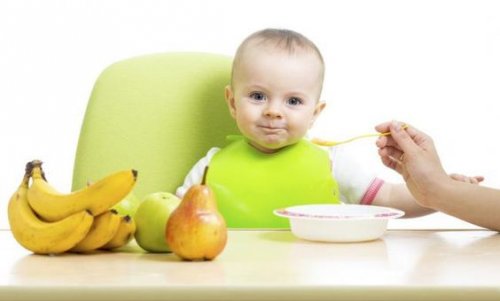Baby's First Foods: How to Incorporate Solid Foods

Breast milk is the best food during the first six months of a baby’s life. After that, they should begin to eat their first solid foods. This is when fears and doubts appear for parents.
There’s no reason to hurry to incorporate solid foods into your baby’s diet. It’s best to consult your pediatrician to help guide you.
There’s a lot of conflicting advice around this subject, which can be confusing and surprising. That’s why in this article we’ll help prepare you for this dietary transition.
How to begin? Which foods should we never give our baby under any circumstance? Why aren’t they eating?
Find out here!
When to incorporate solid foods into your baby’s diet
Most babies being preparing to incorporate solids between 5 or 6 months of age, although each baby is unique.
Here are a series of guidelines that help us decide when our baby is ready to ingest solids:
- Can they keep their head up? One sign is that the baby has control of their head and can lift it by himself or with a little help.
- Are they interested in food? If they open their mouth when food comes near, or they pay attention when adults eat, they’re probably ready to incorporate solids.
- Will they eat food from a spoon? If your child can close their mouth around the spoon while using their lips and tongue to swallow, they’re probably ready for the first solids.
- Weight gain is directly related to an increase in appetite. Therefore, children are ready to incorporate solids into their diet once they double their birth weight. You’ll also notice that their appetite keeps growing.
- Sitting well when supported. If your baby can sit well to eat and maintain an erect position, that’s a good indicator that they may be ready to gradually swallow food.
How to feed them?
Start slowly, with small spoonfuls and talking to the baby during the process. They won’t know what to do at first and they may be confused, play with the food in their mouth or in their hand, reject it outright or wrinkle their nose in disapproval.
Don’t get frustrated if their first solid foods end up on their hair, their face, their hands or their bib. Don’t let them eat while they’re crying. Remember to increase their portions gradually.
The beginning isn’t easy or fast. Introducing solids requires a great deal of patience. That’s why you should think of this moment as a special one. Don’t get impatient or frustrated with your little one!

In this sense, pediatricians advise calmly feeding solids to your baby for the first time. Remember that purees don’t replace breast milk. They are an addition to your baby’s diet at this age.
Likewise, experts recommend: the mother shouldn’t appear anxious. Additionally, don’t add “condiments” to entice the baby. Many mothers fall into the trap of adding honey, sugar, salt, or oil to their baby’s foods.
Of course, avoid adding condiments as they aren’t healthy for such young children, and distance them from good dietary habits.
Also, avoid commercial baby foods with dyes and additives. There’s no food like homemade. Be patient, the process takes time and dedication!
It’s time! Where to start?
The idea of incorporating solids or semisolids initially is more for the sake of learning than for nutrition. It’s a complimentary habit to breastfeeding.
In this stage, you can begin to give them:
- Vegetable purees. These tend to be the first solid foods that the pediatrician recommends adding to their diet. You can begin to introduce potato, carrot, and pumpkin, in that order. Later you can make the famous tricolor puree, which is a mix of all three.
- Fruit purees. You can incorporate solids like pear and apple. Especially when they’re preserved, they’re less acid and have an easier consistency to digest. They’re better tolerated by the baby. Later, in addition to increasing the quantity you offer to the baby, you can offer a variety and include oranges and other fruits. Any fruit can be offered pureed, in its natural state or cooked as a preserve. Regardless of how they are served, they provide vitamins, proteins, minerals, and fibers.
- Grains. The next step in giving the first foods to your child is to incorporate legumes like polenta, rice, and noodle soups. It’s important to make sure that the grains are gluten-free. Gluten is a protein present in wheat, oatmeal, barley, and rye. Gluten can be poorly tolerated by children, triggering celiac disease, which manifests with a variety of symptoms.
Experts suggest incorporating solids in a gradual manner, one at a time. Wait at least two days before trying a new food to observe any possible allergic reactions. Diarrhea, vomit, swelling, rashes and difficulty breathing are red flags.
The best thing to do is consult a pediatrician about which foods to start with and when is a good time to start adding new ones.
The doctor will probably discourage foods that can typically be allergenic like soy, dairy products, eggs, wheat, fish, peanuts, and chocolate.

Incorporate solids: Additional considerations for their first foods
It’s a great goal to have your child get used to a variety of foods. Remember that the transition will take time and adjustment to each new taste and texture.
Don’t get mad if they don’t like a particular flavor. Just offer it to them again later on.
Also, don’t leave anything out of your baby’s diet just because you don’t like it. Don’t forget to give them water and try including natural juices to their diet. They will love them!
Allergies and foods to avoid
Specialists suggest not including certain foods before one year of age. This is especially true if someone in the family has allergies.
On the other hand, certain foods should be avoided until three years of age because they don’t dissolve quickly in the mouth and your child could choke. Avoid:
- Eggs
- Fish
- Dairy
- Chocolate
- Strawberries and kiwis
- Soy
- Gluten (wheat, oats, rye, and barley)
- Honey
- Peanuts
- Corn kernels
- Popcorn
- Hard caramels
- Nuts
All cited sources were thoroughly reviewed by our team to ensure their quality, reliability, currency, and validity. The bibliography of this article was considered reliable and of academic or scientific accuracy.
- NHS. What to feed your baby. Public Health England Service. Consultado el 9 de febrero de 2023. https://www.nhs.uk/start4life/weaning/what-to-feed-your-baby/around-6-months/
- Centers for Disease Control and Prevention. (2020). Timing of introduction of Complementary Foods, United States 2016-2018. U. S. Department of Health and Human Services. Consultado el 9 de febrero de 2023. https://www.cdc.gov/mmwr/volumes/69/wr/mm6947a4.htm
- Centros para el Control y la Prevención de Enfermedades. (2020). Cuándo, qué y cómo introducir alimentos sólidos. Departamento de Salud y Servicios Humanos. Consultado el 9 de febrero de 2023. https://www.cdc.gov/nutrition/infantandtoddlernutrition/foods-and-drinks/cuando-introducir-alimentos-solidos.html
- Clínica Mayo. (2021). Alimentos sólidos: cómo preparar a tu bebé para comenzar. Consultado el 9 de febrero de 2023. https://www.mayoclinic.org/es-es/healthy-lifestyle/infant-and-toddler-health/in-depth/healthy-baby/art-20046200
- D’Auria E., Bergamini M, et al. (2018). Baby led weaning: what a systematic review of the literature adds on. Italian Journal of Pediatrics. 44 (1): 49. https://pubmed.ncbi.nlm.nih.gov/29724233/
- Gómez Fernández-Vegue M. (2018). Recomendaciones de la AEP sobre alimentación complementaria. Consultado el 9 de febrero de 2023. https://www.aeped.es/sites/default/files/documentos/recomendaciones_aep_sobre_alimentacio_n_complementaria_nov2018_v3_final.pdf
- Kramer M. S, Kakuma R. (2012). Optimal duration of exclusive breastfeeding. Cochrane Database of Systematic Reviews. 8: CD003517. https://www.cochrane.org/CD003517/PREG_optimal-duration-of-exclusive-breastfeeding#:~:text=The%20results%20of%20two%20controlled,months%20followed%20by%20mixed%20breastfeeding.
- Romero Velarde E, Villalpando Carrión S, et al. (2016). Consenso para las prácticas de alimentación complementaria en lactantes sanos. Boletín Médico del Hospital Infantil de México. 73 (5): 338-356. https://www.sciencedirect.com/science/article/pii/S1665114616301022
- Yee A. Z, Lwin M. O, et al. (2017). The influence of parental practices on child promotive and preventive food consumption behaviors: a systematic review and meta-analysis. International Journal of Behavioral Nutrition and Physical Activity. 47. https://ijbnpa.biomedcentral.com/articles/10.1186/s12966-017-0501-3
- Generalitat de Catalunya. Departament de Salut. (2016). Recomanacions per a l’alimentació en la primera infància (de 0 a 3 anys). Consultado el 9 de febrero. https://scientiasalut.gencat.cat/handle/11351/2213?locale-attribute=es
This text is provided for informational purposes only and does not replace consultation with a professional. If in doubt, consult your specialist.



